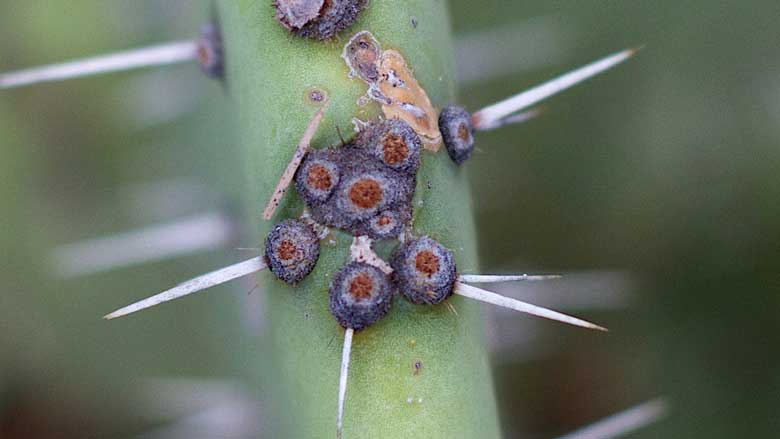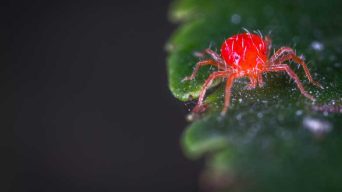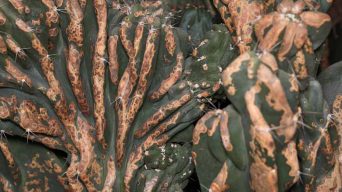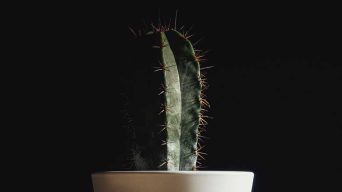Scale insects harm cacti by feeding on sap, causing discoloration and damage. Detect them by whitish bumps on stems and leaves. Treat with neem oil, insecticidal soap, or rubbing alcohol. Prevention includes adjusting watering, using well-draining soil, ensuring good ventilation, regular repotting, and introducing beneficial insects.
Cactus plants are frequently troubled by scale, a pervasive pest that poses a considerable challenge for eradication.
Scale insects attach themselves to the stems and leaves of the plant, extracting essential nutrients required for its survival.
If left unaddressed, a scale infestation can be fatal for your cacti.
Fortunately, there are numerous effective methods for eliminating scale once it appears.
This article aims to comprehensively cover the topic of scale on cactus plants and provide practical guidance on treating it promptly.
What Are Scale Bugs
Scale insects come in various types, but only a select few pose a threat to cacti. These insects manifest as oval or flat bumps on the plant’s stems and leaves.
The most prevalent type is the armored scale, identified by the waxy shell it secretes for self-protection, shielding its body and eggs from predators, parasites, and fungi.
Using needle-like mouthparts known as stylets, it extracts plant juices. While mostly stationary, armored scale insects are vulnerable to scale predators.
These insects emit a chemical deterrent, safeguarding them from predators. Soft-scale insects exhibit a lighter color, resembling their armored counterparts but lacking outer coverings.
They release chemicals to ward off ants, attracting these insects for sustenance rather than facing predators or parasites.
Among the cacti-dwelling scales, the cochineal scale is less harmful to plants than armored scale insects.
Historically prized for its vibrant red dye, this scale is no longer commercially harvested due to the environmentally damaging processes involved in dye production and the potential health risks associated with its use.
Why Cacti Develop Scale Insects
Cacti are an incredibly resilient plant, able to survive in arid conditions.
They are also very low-maintenance plants that require little care and typically do not need water for weeks.
However, scale can still be a problem for succulents and cacti because scale insects eat the sap from your cactus plant instead of sucking out juices or attacking leaves or stems.
Scale insects are attracted to cacti because most feed on a type of tree or shrub, and many scale species have developed a taste preference for the sap in succulent stems.
Scale can get to cactus plants in several ways.
This pest may be brought to your succulents by ants or other scale insect carriers, by wind-blown adults that have hatched from the scale variety’s eggs, or they could even hitchhike on you when you move plants around too roughly.
Scale insects can infest your succulents if they land on it and attach themselves to the plant. The scale insect will then begin feeding off your cactus sap, which can eventually kill it (or at least damage it).
Identifying Scale Insects on Cactus Plants
Scale bugs appear whitish and are visible to the naked eye, resembling tiny dots covering your plant’s leaves, stem, or branches. Typically, they congregate in groups or colonies, making them easily identifiable.
In more severe instances, entire stems may be engulfed, hindering photosynthesis and causing damage such as yellowing and eventual drop-off.
Symptoms of scale infestation manifest in your cactus, evident through leaf discoloration, wilting, or drooping. These indicate the impact on the plant’s ability to absorb water and nutrients from the soil.
Other scale indicators include a slowed growth rate resulting from nutrient deficiency and the emergence of small brown patches on the cactus plant.
These patches may transition to a yellowish hue towards the stem’s center, accompanied by certain areas drying up and displaying a mottled appearance.
Damage Caused by Scale Insects on Cacti
Scale is an insect that lives on cactus plants. Scale can cause damage to cacti by harming the plant’s stems and leaves, causing discoloration.
Scale reproduces rapidly, making removing from your succulent plants more challenging. Some of the symptoms the scale might leave behind are:
- Yellowing spots or brown patches on leaf surfaces
- Deformed new growth (especially in young seedlings)
- Sticky exudate (material secreted by certain organisms) is often called honeydew
- Black sooty mold growing on the surface of scales’ eggs and honeydew
- Premature drop off of flower buds, fruit clusters, or entire branches
- Twig dieback (death of small-to-large sections of a stem)
- Scale infestation can also be a sign of ants
Scale is generally not fatal to cacti, but it will cause plant damage if left untreated, and scale should permanently be removed from the leaves as soon as you notice them.
How To Treat a Scale Infestation
Addressing a scale insect infestation on cactus plants involves employing effective methods.
Here are some recommended approaches:
1. Neem Oil
Neem oil is a great scale killer. It is a natural oil made from the fruits and seeds of neem trees, also known as Indian lilac or fever tree.
The organic pesticide contains limonoids that harm pests but not mammals.
Neem oil works by suffocating the scale insect, resulting in death.
To use this method, mix one-part pure cold-pressed neem oil with two parts water and spray it on your cactus plant twice a week for three weeks straight during spring when the scale population increases most often.
2. Insecticidal Soap
One good thing about using soap as a pest control agent is that it can be used even on sensitive succulent plants, such as those found in the cactus family, without harming them.
Insecticidal soap is a practical scale killer that kills mealybugs, whiteflies, spider mites, fungus gnats, and other pests.
To use this method to get rid of scale, you should mix about three tablespoons of pure liquid castile or peppermint soap with one gallon of water.
Stir the solution well before spraying it onto your succulents until thoroughly soaked through its canopy.
You can use a sprayer or soak the plant by dipping the pot into the solution and letting it sit there.
3. Soap and Water Solution
Another scale killer that you can use is a dish soap and water solution.
All you need to do is mix one tablespoon of liquid dishwashing detergent or pure castile soap with two cups of water, then dip a clean cloth into the mixture and wipe it gently on your cactus plant until all parts are covered evenly.
Then rinse it thoroughly with plain water afterward.
4. Rubbing Isopropyl Alcohol
If you want an organic scale killer that is less harmful to house pets and small children, rubbing alcohol may be the best choice.
This scale removal method works by dissolving scale insects’ protective coating on their bodies, so they die due to dehydration.
To use this solution, wet a cotton ball or soft cloth with pure 99% isopropyl (rubbing) alcohol and wipe it gently onto your cactus plant until all parts are covered evenly.
Then, let everything dry naturally in a well-ventilated area before returning any potted plants inside if needed.
You can spray some liquid into your succulent planter instead of dipping it directly into the solution, as you did when removing the scale using dish soap and water.
5. Wipe Them Off
This scale removal method is simplest since you need to wipe scale insects off your plant using a cotton swab dipped in alcohol or some other scale insecticide.
You can even use this method for indoor cactus plants, but ensure it stays far away from children and pets who may be tempted to put them inside their mouths.
Note: Do not use any soap solution on succulents with waxy leaves like those found on cacti because they are susceptible to chemicals that might cause leaf burn or death due to desiccation (drying out).
Dip the cotton ball into pure rubbing alcohol instead if needed.
6. Spraying Insecticides
If none of these scale-killing methods work well enough for you, then an insecticide spray may be the best scale removal solution.
Various scale killers work well on cacti, so you can choose any scale insecticide labeled for scale and cacti.
Read the label carefully before purchasing anything, especially if your current houseplant has sensitive leaves because some sprays can also harm them!
Preventing Scale Insects
The best scale prevention method is to regularly inspect your cactus plants and wipe them clean using a cotton swab dipped in alcohol or other scale insecticide solution if you find any scale insects trying to settle.
There are several scale prevention methods that you can use to ensure scale insects never infest your succulents again.
Adjusting Watering Practices
Most scale insects are more likely to appear when your cactus plants are overwatered.
This is because scale insects like moist, dark areas where they can suck on the sap of your cacti without being seen.
Choosing Succulent Soil for Cactus Growth
Always use a succulent or cactus potting mix with plenty of sand and grit to ensure good drainage and airflow around the roots of your cactus plants.
Ensuring Well-Ventilated Placement
Scale insects tend to thrive best in moist, humid conditions, so always place your scale-infested cactus plants somewhere with good air circulation and sun exposure for the best scale prevention results!
Regular Repotting
Another scale prevention method is to repot your cactus plants every few years because scale insects can lay eggs in the soil of old, overgrown potted plants.
When you bring them back indoors during wintertime, always inspect for scale and remove any that you find immediately before they infest your entire collection!
Introducing Beneficial Insects
Another scale prevention method is introducing beneficial insects like ladybugs or lacewings into your cactus garden, which will help attack and eat scale bugs whenever they try settling.
Beneficial insects like ladybugs and lacewings love scale bugs as a food source, too, so they can be very helpful in ridding your garden of scale infestations naturally!
Final Thoughts
Dealing with scale insects on cactus plants is a frequent issue, but fortunately, it’s easily manageable, whether it’s in your home or garden.
Act promptly when you notice scale, particularly if ants are present, as they often coincide with a scale infestation.
Swift action is crucial because unchecked scale can result in leaf loss, yellowing foliage, and even the demise of your cherished succulent. Don’t delay – take immediate steps to address the issue!







